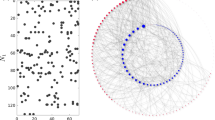Abstract
Motivated by biological aging dynamics, we introduce a network evolution model for social interaction networks. In order to study the effect of social interactions originating from biological and sociological reasons on the topological properties of networks, we introduce the activitydependent rewiring process. From the numerical simulations, we show that the degree distribution of the obtained networks follows a power-law distribution with an exponentially decaying tail, P(k) ∼ (k + c)−γ exp(−k/k 0). The obtained value of γ is in the range 2 < γ š 3, which is consistent with the values for real social networks. Moreover, we also show that the degree-degree correlation of the network is positive, which is a characteristic of social interaction networks. The possible applications of our model to real systems are also discussed.
Similar content being viewed by others
References
M. E. J. Newman, Networks: An Introduction (Oxford University Press, Oxford, 2010).
S-H. Yook, H. Jeong and A-L. Barabási, Proc. Nat. Acad. Sci. 99, 13382 (2002).
Y. Kim, J-H. Kim and S-H. Yook, Phys. Rev. E 83, 056115 (2011).
S-H. Yook, Z. Oltvai and A-L. Barabási, Proteomics 4, 928 (2003).
H. Ebel, L-I. Mielsch and S. Bornholdt, Phys. Rev. E 66, 035103(R) (2002).
D. J. Watts and S. H. Strogatz, Nature 393, 440 (1998).
R. Albert, H. Jeong and A-L. Barabási, Nature 401, 130 (1999).
M. E. J. Newman, Phys. Rev. E 64, 016131 (2001).
R. Albert and A-L. Barabási, Rev. Mod. Phys. 74, 47 (2002).
A-L. Barabási, R. Albert and H. Jeong, Physica A 272, 173 (1999).
P. Erdös and A. Rényi, Publ. Math-Debrecen 6, 290 (1959).
M. E. J. Newman, Phys. Rev. Lett. 89, 208701 (2002).
S-H. Yook and H. Meyer-Ortmanns, Phys. Rev. E 72, 045105(R) (2005).
L. K. Gallos, C. Song, S. Havlin and H. A. Makse, Proc. Nat. Acad. Sci. 104, 7746 (2007).
C. Li and P. K. Maini, Phys. Rev. E 72, 045102(R) (2005).
D. Stauffer, S. M. de Oliveira, P. M. C. de Oliveira and J. S. Sá Martins, Biology, Sociology, Geology by Computational Physicists (Elsevier, Amsterdam, 2006).
T. J. P. Penna, J. Stat. Phys. 78, 1629 (1995).
D. Stauffer, Biological Evolution and Statistical Physics, edited by M. Lässig and A. Valleriani (Springer, Berlin-Heidelberg, 2002), p. 258.
B. Gompertz, Philos. T. R. Soc. Lond. 115, 513 (1825).
M. Magdoń-Maksymowicz, A. Z. Maksymowicz and K. Kułakowski, Theor. Biosci. 119, 139 (2000).
H. Jeong, S. P. Mason, A.-L. Barabási and Z. N. Oltvai, Nature 411, 41 (2001).
A. Vázquez, A. Flammini, A. Maritan and A. Vespignani, ComPlexUs 1, 38 (2003).
V. Colizza, A. Flammini, A. Maritan and A. Vespignani, Physica A 352, 1 (2005).
R. Pastor-Satorras, A. Vázquez and A. Vespignani, Phys. Rev. Lett. 87, 258701 (2001).
S. Scellato and C. Mascolo, in 2011 IEEE Conference on Computer Communication Workshops (INFOCOM WKSHPS, 2011), p. 918.
Author information
Authors and Affiliations
Corresponding author
Rights and permissions
About this article
Cite this article
Kim, Y., Choi, W. & Yook, SH. Modified Penna bit-string network evolution model for scale-free networks with assortative mixing. Journal of the Korean Physical Society 60, 621–624 (2012). https://doi.org/10.3938/jkps.60.621
Received:
Accepted:
Published:
Issue Date:
DOI: https://doi.org/10.3938/jkps.60.621




